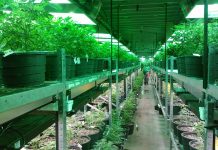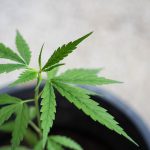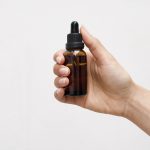U.S, May 10, 2021 (ANALYTICAL CANNABIS) The drying and curing of plants are important stages in the production of cannabis products, particularly when the intent is to consume the plant in its flower form. Drying removes most of the moisture and curing impacts the flavor profile and effects of the bud.
When drying and curing cannabis, there are some key factors to consider, including temperature, humidity, air flow, and lighting. Even a slight deviance from optimal conditions can be detrimental to the quality of the final product.
In this guide, you’ll discover the importance of drying and curing cannabis and the main factors to consider when devising your own process.
Drying and curing cannabis
After harvest, cannabis plants are dried and then cured. Drying is often the more simple of the two processes and usually involves hanging plants in a controlled environment such that they lose most of their moisture.
Curing essentially refers to further drying of cannabis buds, but plants are stored in containers and lose moisture more slowly than in the initial drying process. Again, strict environmental conditions must be maintained. This process can dramatically impact the flavor profile of the plants and alter their potency. It can also affect the experience of consuming the bud.
Leo Gontmakher, CEO of 4Front Ventures, explains that the curing and drying processes are essential steps that bring out the aroma and flavor of the cannabis plant. “They also prepare the cannabis flower for consumption by removing moisture and unwanted sugars that would typically cause a burning sensation in the throat,” he tells Analytical Cannabis.
Jaraud Wood, the harvest manager at Commonwealth Alternative Care, describes drying and curing as processes where a grower is able to capture all the hard work and time put into the growth of the plant. “If not dried and cured correctly, months of labor during the grow process can be erased,” he says. “The overall goal is to remove the moisture from within the flowers to promote long term storage, while maintaining a high level of secondary metabolites, or cannabinoids, terpenes and flavonoids. These compounds are what gives the finished flower its tastes and effects.”
That said, careful drying and curing of cannabis is not always necessary. Nick Tennant, founder and CTO of Precision Extraction, explains that around fifty percent of products sold at dispensaries are extracts. The consideration for drying and curing cannabis used to make these products will be different from those used for raw plant products.
For example, plants used to produce live resin products might be rapidly freeze-dried immediately after harvest. In many other extracts, you’re going to be removing terpenes and other heat-sensitive molecules from the final product anyway, so exposure to high temperature is less of concern. You also don’t have to worry about bud structure and chlorophyll content, among other factors. Tennant notes that you can often be far more liberal with the heat and timing in these cases.
With the above in mind, the sections below will focus on processes for plants that are to be consumed as flower (bud) rather than extracts.
Drying cannabis
The drying process begins immediately after harvest and it’s important to ensure that it’s done right. As Graham Farrar, chief cannabis officer of Glass House Farms, explains.
“Each strain will require a different approach to dry properly, but getting the plant stable in the first 24 hours by removing as much water as possible is critical,” he tells Analytical Cannabis. “After 24 hours, you can back off and let the plant ease into a slower dry cycle, optimally finishing around the 10 day mark.”
The setup you use to dry the plant will depend on the trimming process you use:
- Dry trimming: If you’re trimming plants after they’ve been dried, then you’ll be able to hang them from a line or hanger. Hanging is preferable as it prevents buds from becoming misshapen. To test plants are ready for trimming, you can try bending a branch. If it bends, it needs more drying. If it snaps, it is ready for trimming and curing.
- Wet trimming: If you trim the plants before drying, then you’ll have smaller plant parts to dry and will need to use a rack. You can check when buds are ready for curing by squeezing them. If they still feel wet or moist, they likely need more time before moving on to curing.
As noted by Wood, the main factors to consider when drying are the environmentals: temperature, humidity, air flow, and lighting.
Temperature is key and you need to find a balance. “Yes, it must be warm enough for the product to lose its moisture. However, product degradation can begin as low as 68 degrees Fahrenheit,” explains Wood.
One example he provides is the terpene myrcene (also found in mangos). “This begins to volatilize at low temperatures, so in order to maintain aromas and flavors, we must keep the temperature of the drying space low.”
There’s also a delicate balance when it comes to humidity. “Humidity must be carefully monitored, mainly in order to prevent any mold from growing on the plant. With that said, we also don’t want to over-dry the product where it crumbles to dust,” says Wood.
Air movement is important too. Wood explains that while the plants are hanging, there is a need for constant fresh air movement. This air movement should be subtle and not directly blowing on the plants.
And we shouldn’t forget about lighting. “White light will cause the oils of the plants to rapidly degrade and will cause the plant to continue to create chlorophyll. Chlorophyll is what helps the plant photosynthesize, so this is unwanted during this process,” notes Wood.
Gontmakher explains that every cannabis strain requires a specific amount of cure and dry time. “Drying the cannabis plant, on average, will take about 7–10 days depending on the strain.”
As for conditions, Tennant suggests 50–60 percent humidity at 55–65 degrees. This should help you remove about 80 percent of the moisture. Tennant reiterates the importance of darkness, as light can degrade terpenes and cannabinoids.
Curing cannabis
Once the initial drying stage is complete, curing can begin. This is often described as an artisanal process. Indeed, Tennant likens it to dealing with fine wines. “They’re all aged a little bit differently. Everybody has their process.”
Farrar notes the importance of fine-tuning your setup. “While it is true that you can’t fix a poorly grown plant in cure, you can certainly ruin a properly grown one, so it’s important to get it right. “
Once trimmed, plants are usually loosely packed in glass vessels. For small batches, these could be wide-mouth mason jars; in large-scale production, glass-lined vessels may be used. Again, since this is an artisanal process, there is no one size fits all. Some producers prefer to avoid airtight vessels and instead opt to cure plants in porous containers, such as paper bags or wooden boxes.
The curing process usually takes a little longer than drying, with the plants being stored in a controlled environment for several weeks or more. As Farrar explains, “you need to allow additional time for the moisture to rebalance and spread throughout the bud evenly.”
As with drying, it’s important that the temperature is controlled, as well as humidity and light. Between 55-65 percent humidity and a temperature below 70 degrees Fahrenheit are typical conditions.
Curing is not a “set it and forget it” process, and plants need to be checked regularly. Vessels are typically “burped” at regular intervals, whereby they are opened to let moisture escape and oxygen enter.
It’s important to check the buds for mold, particularly in the early stages of curing. If there is any sign of mold, the jars should be left open for a few hours. An ammonia smell indicates the presence of anaerobic bacteria and is another sign of too much moisture, again requiring vessels to be left open for several hours or longer. Checks can usually be made less frequently as curing progresses.
Conclusion
Overall, the resounding advice when curing and drying cannabis is to follow the “low and slow” and approach. Tennant’s top tip is “Be patient, never try to rush it.” And Wood agrees, explaining that low temperatures promote higher levels of secondary metabolites, and the longer you can cure your product, the cleaner, smoother, and more flavorful your cannabis will be.
Fuente: https://www.analyticalcannabis.com/articles/a-guide-to-drying-and-curing-cannabis-313091










